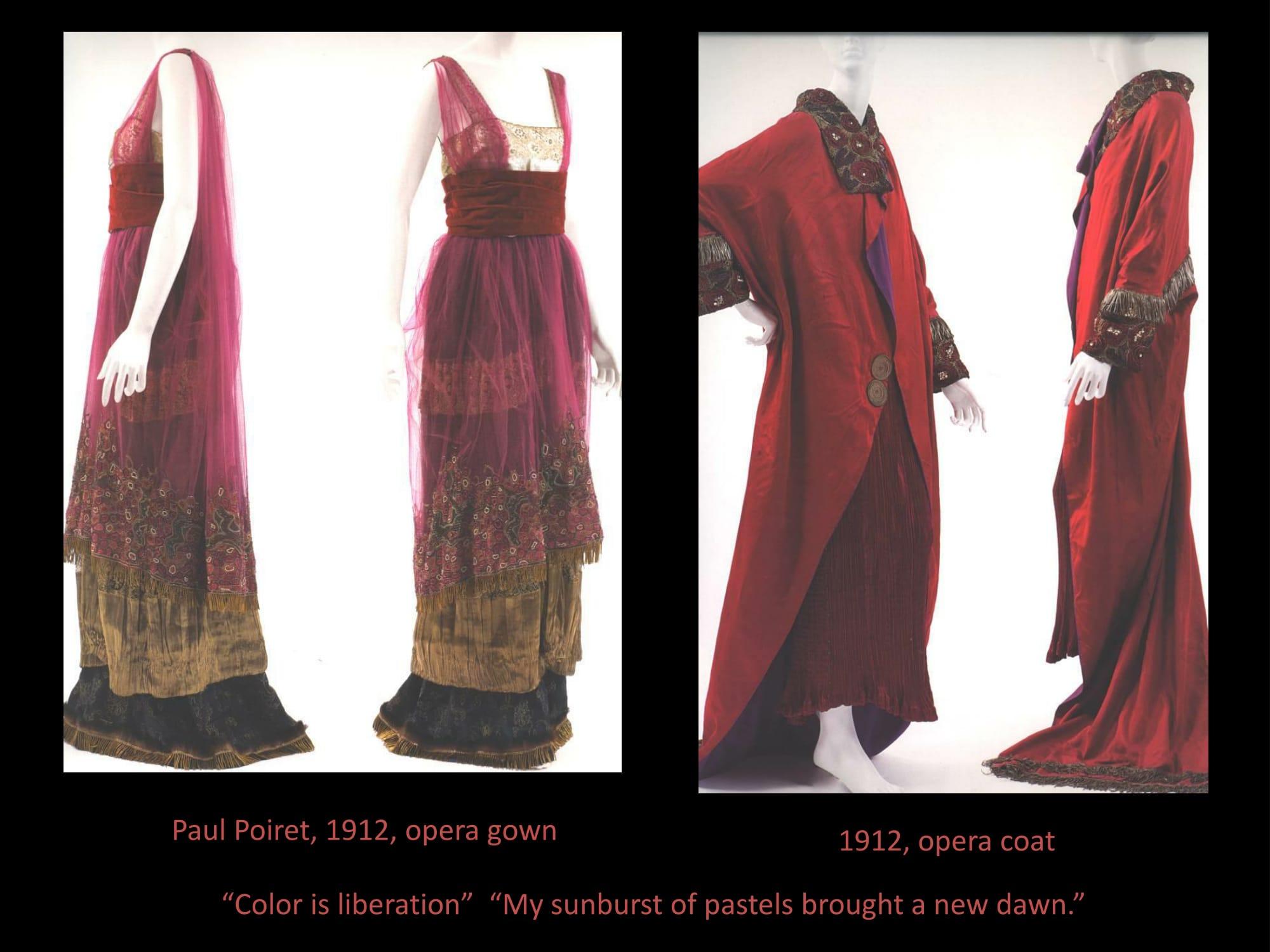Modernism as an approach that dictates the prevalence of functionality above all other characteristics has greatly influenced the style of the early 20th century. Designers have simplified dresses using minimal ornamentation and new materials. At the end of the 19th century, the S-bend corset was introduced, reshaping the female form completely in comparison with the Victorian era. Such designers as Paul Poiret, Coco Chanel, and Elsa Schiaparelli have created trends in modernist fashion that serve as a reference for all current dressmaking. The purpose of this study is to trace the development of fashion in the context of modernism.

According to Brown, “Fashion provides important information including a character’s cultural location, self-presentation, and desires” (297). Modernism has reshaped the outlook of people at the turn of the 20th century. The disappearance of opulent Victorian dresses and close attention to the functionality of clothes attests the major change in the people’s perception of the society and their own image. Researches still argue about the nature of modernist fashion. Plock claims that fashion designers in the 1920s have propagated patriarchal norms (84). Prihutomo argues that the aesthetics of modernist fashion are based on the functionality and the use of new materials (626).
In her book The Mechanical Smile: Modernism and the First Fashion Shows in France and America, 1900–1929, Evans gives a detailed description of a fashion show performed by living mannequins (16). Fashion designers have chosen and prepared women of similar appearance and posture to present their dresses on couture shows, in theaters, and in movies. Their hard work resulted in the distribution of modern fashion dresses in American mass market.

Ephemerality is a significant feature of modernism that is closely connected with the fashion. Burstein repeats the words of Baudelaire and claims that designers create dresses that combine “transitory, fugitive element, whose metamorphoses are so rapid” with “the eternal and the immutable” (219). The combination of new materials and revolutionary designs with oriental and Greek traditions has made Paul Poiret famous in the fashion industry.
Witchard claims that Chinese traditions have greatly influenced the development of modernist style (13). Oliver states that “fashion is a mode of creative expression that quotes the past and embodies the ephemeral, drawing on both stylistics and the ideas that shape society” (362).
Rosenquist and Wood claim that modernist painters let people see their works for a fee and regularly go into the public to know what “low-brow” society thinks about their works (300). Modernist fashion is very much alike visual art in its relation to the public. At the beginning of the 20th century, fashion designers showed their works to common people. They have made fashion available not only for the elite but also for the wide public. Modernist designers explore the trends of elitism and populism (Lee 14).
Modernism has changed the style at the beginning of the 20th century. The prevalence of practical use among all other characteristics in clothes abolished opulent Victorian dresses. S-bend corset has reshaped women anatomy. Fashion has become available for the public. Designers have used simple lines and ornamentation to create practical clothes for active women. Fashion has embodied modernism mixing new materials and ideas in design with oriental and Greek traditions. The modernist ephemerality of forms combined with traditions has created fashion at the beginning of the 1920s.
Works Cited
Brown, Judith. “Glamour’s Silhouette.” A Handbook of Modernism Studies, edited by Jean-Michel Rabaté, John Wiley & Sons, 2013, pp. 297-312.
Burstein, Jessica. “The September Issue: Excess and Austerity in Fashion.” Modernism/modernity, vol. 23, no.1, 2016, pp. 219-231.
Vanderbilt. “Early 20th Century Fashion: Modernism Embodied by the Fashion Designs of Paul Poiret, Coco Chanel, and Elsa Schiaparelli.” Vanderbilt. Web.
Evans, Caroline. The Mechanical Smile: Modernism and the First Fashion Shows in France and America, 1900-1929. Yale University Press, 2013.
Lee, Misuk. “The Comparative Study of the First Ladies’ Fashion Style from a Perspective of Modernism and Postmodernism-Centering around Jacqueline Kennedy and Michelle Obama.” Journal of the Korean Society of Costume. vol. 63, no. 8, 2013, pp. 14-26.
Oliver, Sophie. “Djuna Barnes in a Material World: Fashion and Transatlantic Modernity in the 1910s.” Literature Compass, vol.11, no. 6, 2014, pp. 347-366.
Plock, Vike Martina. “” I Just Took It Straight from Vogue”: Fashion, Femininity, and Literary Modernity in Rosamond Lehmann’s Invitation to the Waltz.” MFS Modern Fiction Studies. vol. 59, no. 1, 2013, pp. 83-106.
Prihutomo, Amanda. “Post Modern Soul in Modern Body.” Advanced Science Letters. vol. 21, no. 4, 2015, pp. 626-630.
Rosenquist, Rod, and Alice Wood. “Introduction: Modernism in Public”. Modernist Cultures, vol. 11, no. 3, 2016, pp. 299-311.
Witchard, Anne. British Modernism and Chinoiserie. Edinburgh University Press, 2015.